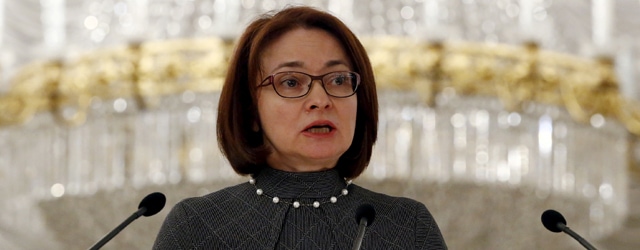Elvira Nabiullina is shutting down bigger and better banks, on a tear through some of the shadier corners of Russia’s financial system.

A slender, soft-spoken woman with a passion for French symbolist poetry may seem an incongruous sheriff for Russia’s unruly banking system. But Central Bank of Russia chief Elvira Nabiullina is wearing the badge fearlessly. Last year, two top CBR lieutenants intimated the regulator was nearly finished culling a scraggly financial herd that has shrunk from more than 1,000 licensed banks to about 600. Nabiullina sacked the deputies and announced she had “only traveled half the road.”
In reality, Russia’s banking sector is heavily concentrated, with the 10 biggest institutions controlling 70% of system assets and the top 100 controlling 94%, says Alexander Danilov, who covers the industry from Fitch Ratings’ Moscow office. Many of the smaller banks exist solely to squirrel funds out of the country by dodgy means. Or rather, they existed until Nabiullina combed through their books and started shutting them down. Suspicious capital flight via banks has dropped from $40 billion in 2012, the year before she took over as central banker, to less than $1 billion, Danilov reports.
Lately the 53-year-old central banker has moved on to bigger (and better-connected) game. Last autumn she shut down Peresvet Bank, whose largest shareholder was the Russian Orthodox Church; and last month she revoked the license of Tatfondbank, partly owned by the provincial government in Tatarstan. Nabiullina is herself an ethnic Tatar, raised in neighboring Bashkortostan before winning a place in the economics department of Moscow State University on the eve of perestroika.
A big open question is how much sway Nabiullina holds over the dominant top 10 banks, the six biggest of them controlled by arms of the federal government. (The CBR itself is a majority shareholder in the system’s giant, Sberbank, whose CEO, Herman Gref, used to be Nabiullina’s boss at the economics ministry.) The regulator has shown “forbearance,” in Danilov’s words, toward balance-sheet weakness at official behemoths like agricultural lender Rosselkhozbank.
Russian reformers can risk more than their jobs by stepping on the wrong toes. Andrei Kozlov, a CBR deputy chairman who spearheaded the first wave of banking clean-ups, was shot dead on a Moscow sidewalk in 2006. Economics minister Alexei Ulyukayev, a wisecracking liberal who locked horns with state oil colossus Rosneft, was arrested last autumn on shaky-looking graft charges and remains under house arrest.
But Nabiullina seems to have won supreme-leader Vladimir Putin’s confidence by steering clear of politics, keeping billions inside Russia, and nurturing the banking system through two years of recession that followed the 2014 oil-price crash. “The financial system made it through all the turbulence quite well, and the CBR’s role was significant,” says Anastasia Turdyeva, a banking analyst with S&P Global in Moscow.
It is hard to find white hats amid the murk of Russian bureaucracy. But Nabiullina and her central bankers seem to be rising to that role when their country needs it most.



